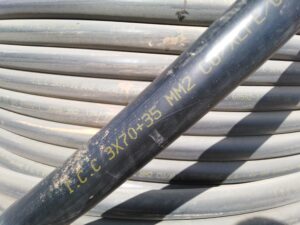If you are involved in the design, installation or maintenance of electrical systems, you might have come across cable tray and trunking.
Although both are used to support, protect, and route cables, they have different characteristics, functions, and applications.
In this article, we will explore the differences between cable tray and trunking in detail, and provide you with a comparison table to summarize the key points.
Table of Contents
What is Cable Tray?

A cable tray is a structural system consisting of rigid or flexible metal or non-metallic units that support and guide electrical cables or wires.
Cable trays are designed to withstand the weight of cables and other loads, and to prevent the formation of hot spots, electromagnetic interference, and cable damage.
They can be mounted on walls, ceilings, floors, or suspended from above, and can be configured in different shapes, sizes, and materials, depending on the requirements of the installation.
Cable trays are commonly used in industrial, commercial, and institutional settings, where there are large quantities of cables that need to be organized and protected.
They are preferred over conduit systems because they are easier to install, modify, and maintain, and can accommodate different types and sizes of cables.
Some of the common types of cable trays include ladder, solid-bottom, wire-mesh, and trough.
Read also my in-depth article Do You Really Need a Cable Tray? Here’s How to Decide.
What is Trunking?
Trunking, also known as conduit or ducting, is a hollow structure that encloses and protects electrical cables or wires, and provides a pathway for their installation and maintenance.
Trunking can be made of metal, plastic, or composite materials, and can be rigid or flexible, depending on the application.
Trunking can be used for both indoor and outdoor installations, and can be surface-mounted or buried in the ground.
Trunking is commonly used in residential, commercial, and small-scale industrial applications, where there are limited numbers of cables that need to be protected and concealed.
Trunking is preferred over cable trays in environments where aesthetics and space are important, as trunking can be painted or hidden behind walls, ceilings, or floors.
Some of the common types of trunking include PVC, metal, flexible, and circular.
Comparison Table
To help you understand the differences between cable tray and trunking, we have created the following comparison table:
| Parameter | Cable Tray | Trunking |
|---|---|---|
| Material | Metal, non-metallic | Metal, plastic, composite |
| Configuration | Ladder, solid-bottom, wire-mesh, trough | PVC, metal, flexible, circular |
| Function | Support, protect, route cables | Enclose, protect, route cables |
| Application | Industrial, commercial, institutional | Residential, commercial, small-scale industrial |
| Installation | Wall, ceiling, floor, suspended | Surface-mounted, buried |
| Advantages | Easy to install, modify, maintain, accommodate different types and sizes of cables | Aesthetically pleasing, concealable, space-saving |
| Disadvantages | Bulky, may require additional supports, less flexible | Limited capacity, difficult to modify or expand, requires frequent maintenance |
Conclusion
Cable tray and trunking are two different types of cable management systems that serve different purposes and have different characteristics.
Cable trays are more suitable for large-scale installations where the number and size of cables are significant, while trunking is more appropriate for small-scale installations where aesthetics and space are important.
By understanding the differences between cable tray and trunking, you can choose the right system for your application and ensure the safety and efficiency of your electrical system.
Don’t Leave Empty-Handed!
Install my Free Android App on Google Play:
Electrical Cables Most Common Tables “Cables Tables”
And, my Electrical Calculations App “Fast Electrical Calculator”
Discover more great content by subscribing to My channel
Looking to stay ahead of the game in the world of electrical engineering? Subscribe to my YouTube channel and gain access to exclusive content you won’t find anywhere else!
The staff I recommend
(Amazon Affiliate Links to products I believe are high quality):
- Economy 120 Volt/60Hz AC Power Source – Step-Down Voltage & Frequency Converters 1800W
- UNI-T Digital Multimeter Tester UT139C
- 50-Amp Extension Cord for RV “100ft”
- Voltage Stabilizer 110/220v
- Hair Dryer “best selling“
- TOSHIBA EM131A5C-BS Countertop Microwave Ovens
Disclaimer: This contains affiliate links to Amazon products. I may earn a commission for purchases made through these links.



